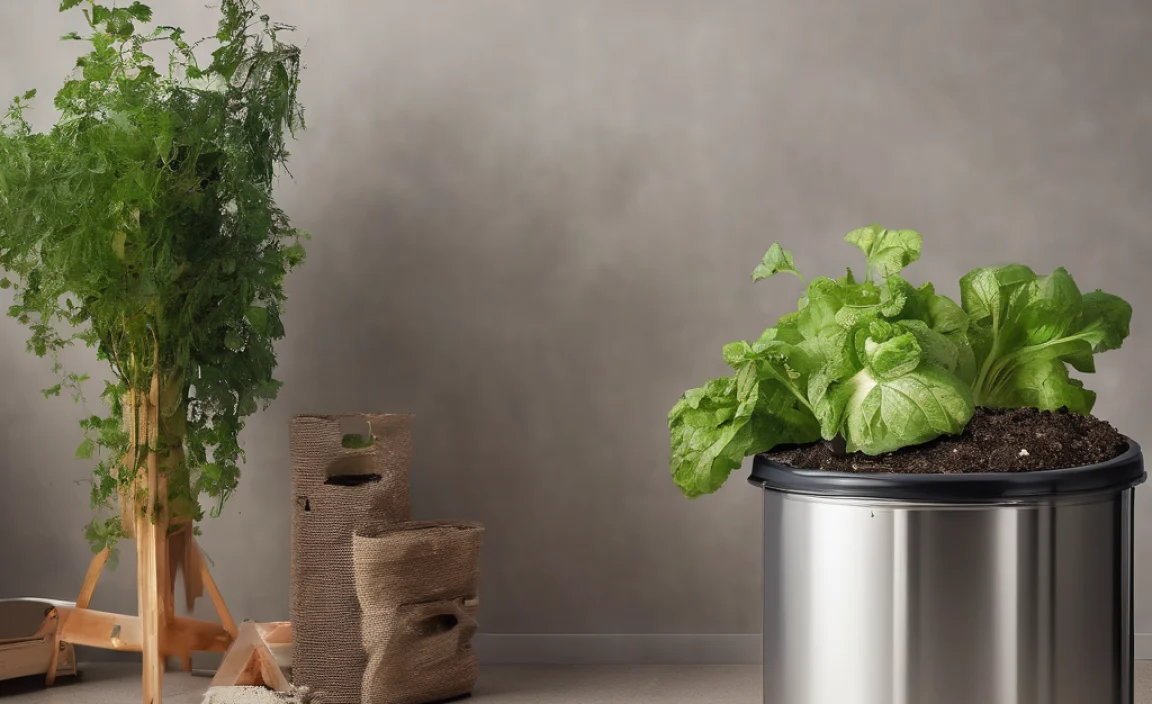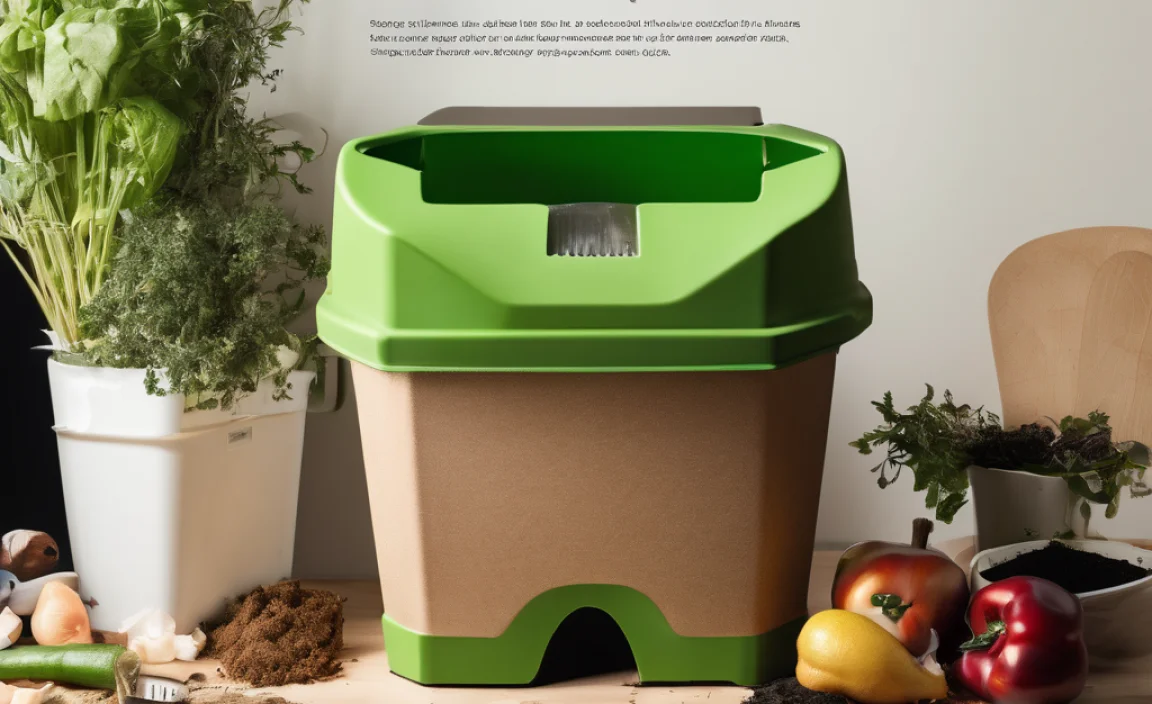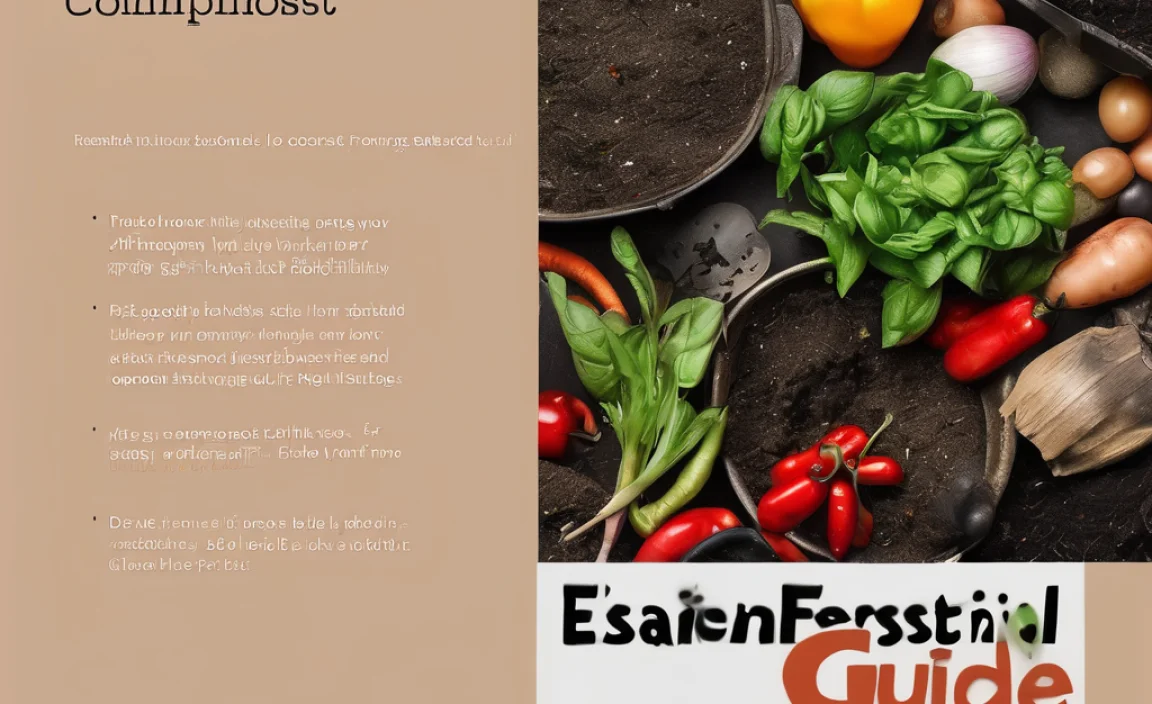Hey there! Feeling buried under food waste at your restaurant? Thinking about composting but worried it’s too pricey or complicated? You’re not alone! Many restaurant owners shy away from composting because they think it costs a fortune and requires a master’s degree in gardening. But what if I told you it’s actually a smart way to save money and is easier to get started than you might think? Stick around, and I’ll show you how.
Composting for Restaurants Cheap: Proven Savings
As a restaurant owner, every penny counts. You’re constantly looking for ways to boost your bottom line while keeping your operations running smoothly. Food waste is a huge expense, often hidden in your trash bills. But what if I told you that turning that waste into compost could be a secret weapon for saving serious cash? It’s true! Composting for restaurants doesn’t have to be expensive. In fact, done right, it’s one of the smartest, cheapest ways to cut down on operational costs.
I’m Troy D Harn, and I’ve helped countless folks figure out the best ways to handle their projects, whether it’s fixing a leaky faucet or starting a compost pile. And I’m here to tell you that composting food scraps at your restaurant is totally doable, budget-friendly, and can actually make you money. We’ll break down exactly how you can start composting without emptying your wallet, and how it’s already saving other businesses like yours a bundle.
Why Composting is a Game-Changer for Your Restaurant’s Budget
Let’s talk numbers for a sec. Food waste is more than just scraps heading to the landfill. It’s the cost of buying that food in the first place, the labor to prepare it, and the hefty fees the city charges you to haul away your trash. When organic materials break down in a landfill, they produce methane, a potent greenhouse gas. Many municipalities are starting to charge more for landfill disposal or cracking down on food waste, making it even more important to find alternatives.
Composting turns this costly problem into a valuable asset. Instead of paying to throw it away, you’re creating a nutrient-rich soil amendment. This can benefit your business in several ways:
- Reduced Waste Disposal Costs: This is the most direct and immediate saving. Less trash means lower hauling fees. Some businesses see a significant drop in their waste bills once they start composting a large portion of their food scraps.
- Potential for Selling Compost: High-quality compost is in demand. If you generate enough, you could sell it to local gardeners, landscapers, or even community gardens.
- Marketing and Brand Image: Customers are increasingly environmentally conscious. Advertising your commitment to sustainability through composting can attract new customers and build loyalty. It’s a feel-good marketing angle that costs very little to implement.
- On-site Gardening Opportunities: If your restaurant has space, you can use your compost to grow herbs, vegetables, or garnishes right on site. This reduces your food sourcing costs and provides the freshest possible ingredients. Imagine serving a signature dish with herbs you grew yourself from composted scraps!
Debunking the “Composting is Expensive” Myth
The biggest pushback I hear is about cost. People picture expensive machinery, massive outdoor bins, or hiring consultants. But the reality of cheap composting for restaurants is much simpler.
The “Chop and Drop” — Your Easiest First Step
The most cost-effective way to start composting is to partner with a local composting facility or a farm that accepts food scraps. Many of these operations are set up to take what you produce, often at a lower cost than traditional waste hauling, or even for free if you’re close enough and they can pick it up as part of their route.
How it works:
- Separate Your Scraps: Train your kitchen staff to separate specific food waste from other trash. This usually includes fruit and vegetable scraps, coffee grounds, tea bags, eggshells, and certain ungreased paper products (like some paper towels or napkins – check with your composting partner).
- Collect in Convenient Bins: Use simple, lidded bins that are easy to manage. Small countertop bins for prep stations and larger rolling bins for main kitchen collection work well.
- Arrange for Pickup: Work with a local composting service. They will often provide specialized bins and regular pickup schedules. The cost is usually a fraction of what you pay for general waste removal.
This “Chop and Drop” method (referring to dropping scraps off at a composting facility) requires minimal investment from your end. Your main costs are simple kitchenware and the service fee, which is often offset by lower trash fees. You can explore options like EPA’s strategies for reducing and reusing food waste, which composting is a key part of.
DIY Composting: When You Have Space and Time
If you have a bit of outdoor space behind your restaurant or a nearby property and are feeling ambitious, you can set up your own composting system. Even this can be done affordably.
Choosing the Right (Cheap!) System
You don’t need fancy equipment. Here are simple, cost-effective options:
- Pallet Bins: You can often get free wooden pallets from businesses and nail them together to create simple, sturdy compost bins. Three or four pallets arranged in a square work perfectly.
- Wire Mesh Bins: A roll of hardware cloth or chicken wire can be formed into a cylinder. This is very cheap and allows for good airflow.
- Tumbler (DIY or Used): While new compost tumblers can be pricey, you can often find used ones at great discounts, or even build your own with some basic DIY skills. Tumblers speed up the composting process.
What to Compost (and What to Avoid)
A good compost “recipe” needs a balance of “greens” (nitrogen-rich) and “browns” (carbon-rich).
Greens (Nitrogen-Rich):
- Fruit and vegetable scraps
- Coffee grounds and filters
- Tea bags
- Eggshells
- Plate scrapings (ensure no meat or grease)
Browns (Carbon-Rich):
- Shredded cardboard (uncoated, no glossy print)
- Shredded newspaper
- Dry leaves (if you have access to them)
- Sawdust (from untreated wood)
- Straw or hay
What NOT to Compost (especially at a restaurant, to avoid pests and odors):
- Meat, fish, and bones
- Dairy products
- Oily or greasy foods
- Diseased plants
- Pet waste
- Coal or charcoal ash
Always check with your local health department or waste management authority for specific regulations regarding restaurant composting, especially if you plan to do it on-site. The EPA’s guide to composting municipal solid waste offers valuable insights into best practices.
Calculating Your Potential Savings
Let’s look at how composting can save you money. This isn’t just theory; businesses are seeing real savings.
Waste Hauling Fees: The Biggest Win
Waste hauling is often priced by volume and frequency of pickup. Food waste can make up a significant portion of a restaurant’s trash volume. By diverting food scraps, you can potentially reduce the size of your dumpster, the number of pickups needed, or switch to a less frequent schedule. This can lead to savings of:
- 10% to 50% or more on your monthly waste bill.
Example Savings Table
| Waste Service Fee Type | Current Monthly Cost | Projected Cost After Composting | Monthly Savings |
|---|---|---|---|
| Dumpster Rental + 3 Pickups/Week | $500 | $300 (Smaller bin, 1 pickup/week) | $200 |
| Tipping Fees (Weight-Based) | $300 | $150 (Reduced overall waste) | $150 |
| Total Before Composting | $800 | Total After Composting | $450 |
| Estimated Monthly Savings by Composting: | $350 | ||
Note: These are illustrative figures. Actual savings will vary based on your location, waste hauler, and the volume of food waste you generate.
The cost of commercial composting services can range from $50 to $200+ per month, depending on pickup frequency and volume. However, this cost is often significantly less than the savings achieved by reducing your overall waste hauling fees.
Reducing Food Purchasing Costs
While not directly a compost savings, reducing food waste in the first place is closely linked. Better inventory management and smarter prep techniques (which go hand-in-hand with effective composting programs) mean less food ends up as waste to begin with. This can save your restaurant hundreds, even thousands, of dollars on food purchases.
Implementing Your Cheap Composting Program: A Step-by-Step Guide
Ready to dive in? Here’s how to get started without breaking the bank.
Step 1: Assess Your Waste Stream
Before you do anything, get a handle on what you’re throwing away. For a week, track the type and amount of food scraps your kitchen generates. This will help you choose the right composting method and a service provider that can handle your volume.
Step 2: Train Your Staff
This is CRUCIAL. Your kitchen staff are the front lines of your composting effort. Hold brief, clear training sessions:
- Explain why you’re composting (cost savings, environment).
- Show them exactly which items to compost.
- Demonstrate how to separate scraps into designated bins.
- Emphasize keeping contaminants (like plastic or metal) out of the compost bins.
Keep visual aids (posters of what’s compostable and what’s not) visible in the kitchen. Make it easy for them!
Step 3: Choose Your Collection Method
Option A: Partner with a Local Composting Service (Most Affordable & Easiest):
- Research local commercial compost collection companies. Search online for “restaurant compost pickup [your city]” or “food waste recycling [your city]”.
- Contact a few. Ask about their pickup schedules, bin sizes and costs, and what materials they accept.
- Often, they can swap out a smaller trash bin for a larger compost bin at a lower overall waste management cost.
Option B: DIY On-Site Composting (Requires Space & Effort):
- Set up your cheap bin: Use salvaged pallets or wire mesh. Position it in a convenient, accessible outdoor location.
- Start layering: Begin with a layer of absorbent brown materials (like shredded cardboard).
- Add food scraps: As you collect them, add them on top and bury them lightly under more brown material. This helps control odors and deter pests.
- Maintain Moisture and Air: Keep the pile about as damp as a wrung-out sponge. Turn it with a pitchfork regularly (every week or two) to introduce air, which speeds up decomposition.
For DIY, ensure your chosen site meets any local health and safety regulations. You might be surprised by the resources available from your local agricultural extension office or university extension programs.
Step 4: Secure Your Collection Bins
For external services, they usually provide the bins. If you’re doing it yourself, buy or build your bins. For indoor collection, opt for small, lidded bins for prep areas. Look for durable, easy-to-clean options.
Step 5: Schedule Pickups or Maintain Your System
Once your service is arranged, stick to the schedule. If you’re composting on-site, establish a routine for turning and monitoring your compost pile. Patience is key – it takes time for organic matter to break down into usable compost.
Making the Most of Your Compost (If You DIY)
Once your on-site compost is ready (it will look, feel, and smell like rich soil), you can use it!
- On-site Herb/Vegetable Garden: This is the ultimate in farm-to-table savings. Use your compost to nourish plants for your kitchen.
- Offer to Local Community Gardens or Farmers: Other gardeners would love your high-quality compost. This can be a goodwill gesture or even a small revenue stream.
- Lessen Landscaping Costs: If you have landscaping around your restaurant, your compost can enrich the soil and reduce the need for purchased fertilizers.
Tips for Keeping Composting Cheap and Efficient
Here are a few extra tricks to keep costs low and your composting program humming:
- Negotiate with Haulers: Even if you keep your current trash service, let them know you’re diverting organics. They might offer you a discount or a more suitable service plan.
- Source Browns for Free: Ask local businesses (coffee shops for grounds, distributors for cardboard boxes, landscaping companies for leaves) if they have free brown materials you can use for DIY composting.
- Educate Your Customers: Let your patrons know about your composting efforts. This strengthens your brand and can even inspire customers to adopt similar practices at home.
- Monitor for Pests and Odors: Proper management is key, especially with DIY. Burying food scraps and ensuring adequate airflow and moisture balance will prevent most issues. If using a service, they handle this for you.
- Start Small and Scale Up: You don’t have to compost everything from day one. Start with your biggest waste producers (like vegetable peelings) and expand as your team gets comfortable.
Frequently Asked Questions
Here are some common questions restaurant owners have when considering cheap composting.
How much space do I really need for composting?
For partnering with a service, you only need space for the collection bins provided by the company. For DIY, a small footprint (e.g., 3×3 feet for a pallet bin) is often enough, depending on your volume. The key is having an accessible, out-of-the-way location.
What kind of bins are best for a restaurant kitchen?
For inside the kitchen, small, lidded countertop bins are ideal for prep stations. For collection awaiting pickup, larger, sturdy rolling bins with tight-fitting lids are best to manage volume and prevent odors and pests.
How do I train my staff effectively on composting?
Keep it visual and simple. Use clear posters showing exactly what to compost and what to avoid. Provide hands-on demonstrations. Make it a part of your regular kitchen briefings. Celebrate small successes! For example, a simple sign with pictures is a great start.
Will composting attract pests or create bad smells?
When done correctly, it shouldn’t. Partnered services manage this professionally. For DIY, burying food scraps under brown materials, maintaining proper moisture levels, and adequate airflow are key to preventing odors and deterring pests. Avoid composting meat, dairy, and greasy foods, as these are the main attractants.
How long does it take for food scraps to turn into compost?
This varies greatly. A fast-managed hot compost pile can produce finished compost in 1-3 months. A slower, cooler pile or a poorly managed one can take 6 months to over a year. Tumblers and regular turning speed up the process.
What if my city has specific regulations about restaurant composting?
It’s essential to check with your local health department, sanitation department, or waste management authority. Many cities now have pilot programs or mandates for food waste diversion. They can guide you on what’s permissible and any required permits or protocols.
Can I use composting to grow herbs for my restaurant?
Absolutely! Once your compost is fully decomposed and “cured” (meaning it’s stable and nutrient-rich), it’s an excellent soil amendment for growing herbs and vegetables. This is a fantastic way to reduce food costs and increase freshness.

I am passionate about home engineering. I specialize in designing, installing, and maintaining heating, ventilation, and air conditioning systems. My goal is to help people stay comfortable in their homes all year long.



